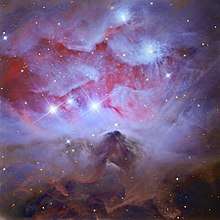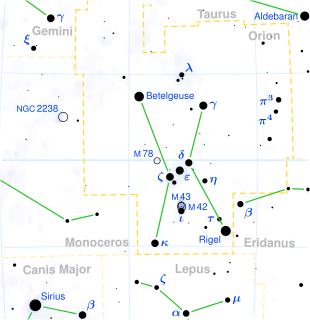42 Orionis
42 Orionis is a class B1V[3] (blue main-sequence) star in the constellation Orion. Its apparent magnitude is 4.59[2] and it is approximately 900 light years away based on parallax.[1]
| Observation data Epoch J2000 Equinox J2000 | |
|---|---|
| Constellation | Orion |
| Right ascension | 05h 35m 23.16427s[1] |
| Declination | −4° 50′ 18.0881″[1] |
| Apparent magnitude (V) | 4.59[2] |
| Characteristics | |
| Spectral type | B1V[3] |
| U−B color index | -0.94[2] |
| B−V color index | -0.19[2] |
| Astrometry | |
| Radial velocity (Rv) | +28.40[4] km/s |
| Proper motion (μ) | RA: +4.52[1] mas/yr Dec.: -7.11[1] mas/yr |
| Parallax (π) | 3.69 ± 1.20[1] mas |
| Distance | approx. 900 ly (approx. 270 pc) |
| Details | |
| Mass | 12.0[5] M☉ |
| Temperature | 25,400[6] K |
| Rotational velocity (v sin i) | 20[7] km/s |
| Other designations | |
| Database references | |
| SIMBAD | data |

42 Ori is the bright star at the centre of NGC 1977. (Mount Lemmon SkyCenter Schulman Telescope courtesy Adam Block
The primary star, Aa, has one spectroscopic companion Ab of magnitude 6.3 and separation 0.16", and a more distant companion B of 7.5 magnitude at 1.6" separation.[8][9]
c Orionis is surrounded by NGC 1977 one of a smaller fainter group of named nebulae just north of the Orion Nebula. c Ori is the star which excites and illuminates NGC 1977.
References
- Van Leeuwen, F. (2007). "Validation of the new Hipparcos reduction". Astronomy and Astrophysics. 474 (2): 653. arXiv:0708.1752. Bibcode:2007A&A...474..653V. doi:10.1051/0004-6361:20078357. Vizier catalog entry
- Ducati, J. R. (2002). "VizieR Online Data Catalog: Catalogue of Stellar Photometry in Johnson's 11-color system". CDS/ADC Collection of Electronic Catalogues. 2237. Bibcode:2002yCat.2237....0D.
- Hoffleit, D.; Warren, W. H. (1995). "VizieR Online Data Catalog: Bright Star Catalogue, 5th Revised Ed. (Hoffleit+, 1991)". VizieR On-line Data Catalog: V/50. Originally Published in: 1964BS....C......0H. 5050. Bibcode:1995yCat.5050....0H.
- Gontcharov, G. A. (2006). "Pulkovo Compilation of Radial Velocities for 35 495 Hipparcos stars in a common system". Astronomy Letters. 32 (11): 759. arXiv:1606.08053. Bibcode:2006AstL...32..759G. doi:10.1134/S1063773706110065.
- Tetzlaff, N.; Neuhäuser, R.; Hohle, M. M. (2011). "A catalogue of young runaway Hipparcos stars within 3 kpc from the Sun". Monthly Notices of the Royal Astronomical Society. 410: 190. arXiv:1007.4883. Bibcode:2011MNRAS.410..190T. doi:10.1111/j.1365-2966.2010.17434.x. Vizier catalog entry
- Hohle, M.M.; Neuhäuser, R.; Schutz, B.F. (2010). "Masses and luminosities of O- and B-type stars and red supergiants". Astronomische Nachrichten. 331 (4): 349. arXiv:1003.2335. Bibcode:2010AN....331..349H. doi:10.1002/asna.200911355. Vizier catalog entry
- Abt, Helmut A.; Levato, Hugo; Grosso, Monica (2002). "Rotational Velocities of B Stars". The Astrophysical Journal. 573: 359. Bibcode:2002ApJ...573..359A. doi:10.1086/340590.
- Mason, Brian D.; Wycoff, Gary L.; Hartkopf, William I.; Douglass, Geoffrey G.; Worley, Charles E. (2001). "The 2001 US Naval Observatory Double Star CD-ROM. I. The Washington Double Star Catalog". The Astronomical Journal. 122 (6): 3466. Bibcode:2001AJ....122.3466M. doi:10.1086/323920. Vizier catalog entry
- Tokovinin, Andrei; Mason, Brian D.; Hartkopf, William I.; Mendez, Rene A.; Horch, Elliott P. (2015). "Speckle Interferometry at Soar in 2014". The Astronomical Journal. 150 (2): 50. arXiv:1506.05718. Bibcode:2015AJ....150...50T. doi:10.1088/0004-6256/150/2/50.
This article is issued from Wikipedia. The text is licensed under Creative Commons - Attribution - Sharealike. Additional terms may apply for the media files.
